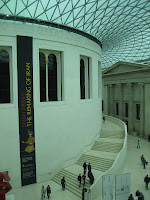
The year 2000 marked the completion of the reconstruction of the Great Court of the British Museum. The formal opening of the Queen Elizabeth II Great court was conducted by Her Majesty the Queen on December 6, 2000. The Reading room stands at the center of the courtyard encircled by two grand staircases leading to the Joseph Hotung Great Court Gallery and the Court Restaurant. The inner courtyard is enclosed by a magnificent glass and steel roof which transforms the space and adds a contemporary twist to the Roman-inspired architecture. Upon entering the Great Court, my eyes were automatically drawn upwards to the glass roof. The combination of steel framing, glass panels and geometric shapes reminded me of the Pyramids at the Louvre, though the Pyramids had diamond-shaped glass panels while these were triangular. From the eggshell walls to the glass ceiling, all these different design elements
 come together to create a space that is both light and airy.
come together to create a space that is both light and airy.Displayed in the Asia room is the Shiva Nataraja. In Hindu belief, Shiva manifests five aspects of eternal energy: creation, preservation, destruction, concealment, favor. The bronze figure illustrates the Hindu god Shiva appearing as the Lord of the Dance in a ring of fire (representing cosmic activity), lifting his leg and balancing over the dwarf of ignorance, Apasmara. His long hair flows out as he performs his dance and nestled within it is the goddess Ganga. In his upper right hand he holds a double sided drum representing the primordial sound of creation. The upper left hand holds a flame, which signifies destruction. The opposing concepts in upper hands show the counterpoise of creation and destruction. He makes the gesture ‘have no fear’ and points to his raised left foot, symbolizing liberation.
Nice!
ReplyDelete